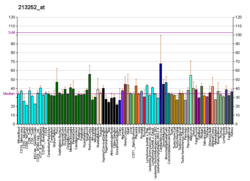| SH3PXD2A |
|---|
 |
| Available structures |
|---|
| PDB | Ortholog search: PDBe RCSB |
|---|
| List of PDB id codes |
|---|
2DNU, 2EGA, 2EGC, 2EKH |
|
|
| Identifiers |
|---|
| Aliases | SH3PXD2A, FISH, SH3MD1, TKS5, SH3 and PX domains 2A |
|---|
| External IDs | MGI: 1298393 HomoloGene: 7317 GeneCards: SH3PXD2A |
|---|
| Gene location (Human) |
|---|
 | | Chr. | Chromosome 10 (human)[1] |
|---|
| | Band | 10q24.33 | Start | 103,594,027 bp[1] |
|---|
| End | 103,855,543 bp[1] |
|---|
|
| Gene location (Mouse) |
|---|
 | | Chr. | Chromosome 19 (mouse)[2] |
|---|
| | Band | 19|19 C3 | Start | 47,248,613 bp[2] |
|---|
| End | 47,452,840 bp[2] |
|---|
|
| RNA expression pattern |
|---|
| Bgee | | Human | Mouse (ortholog) |
|---|
| Top expressed in | - cervix
- sural nerve
- trigeminal ganglion
- tibia
- inferior ganglion of vagus nerve
- myometrium
- vagina
- cecum
- tendon
|
| | Top expressed in | - molar
- ascending aorta
- sciatic nerve
- aortic valve
- body of femur
- belly cord
- calvaria
- skin of abdomen
- utricle
- brown adipose tissue
|
| | More reference expression data |
|
|---|
| BioGPS | 
 | | More reference expression data |
|
|---|
|
| Gene ontology |
|---|
| Molecular function | - protein binding
- superoxide-generating NADPH oxidase activator activity
- phosphatidylinositol binding
- protease binding
- phosphatidylinositol-4,5-bisphosphate binding
- phosphatidylinositol-5-phosphate binding
- phosphatidylinositol-3-phosphate binding
- phosphatidylinositol-3,4-bisphosphate binding
- phosphatidylinositol-4-phosphate binding
| | Cellular component | - cytoplasm
- podosome
- cell junction
- cell projection
- cytosol
| | Biological process | - osteoclast fusion
- superoxide metabolic process
- reactive oxygen species metabolic process
- positive regulation of catalytic activity
- podosome assembly
- extracellular matrix organization
| | Sources:Amigo / QuickGO |
|
| Orthologs |
|---|
| Species | Human | Mouse |
|---|
| Entrez | | |
|---|
| Ensembl | | |
|---|
| UniProt | | |
|---|
| RefSeq (mRNA) | | |
|---|
NM_001164717
NM_008018
NM_177833 |
|
|---|
| RefSeq (protein) | | |
|---|
| Location (UCSC) | Chr 10: 103.59 – 103.86 Mb | Chr 19: 47.25 – 47.45 Mb |
|---|
| PubMed search | [3] | [4] |
|---|
|
| Wikidata |
| View/Edit Human | View/Edit Mouse |
|



















